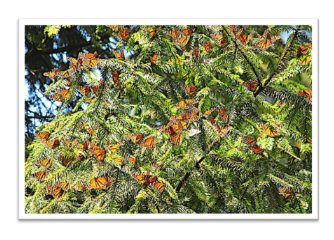MY VISIT TO THE MONARCH OVERWINTERING SITES IN MEXICO MADE ME A BETTER HOUSTON MONARCH GARDENER!
By DIANE RUSSELL, Ph.D. Past President Texas Master Naturalists/Coastal Prairie Chapter

Mexican Monarch Wintering Site (Diane Russell Photo)
In February 2017 I joined a conservation tour group, led by the late Dr. Tom Emmel of the University of Florida, to videotape the incredible phenomenon found at the monarch overwintering sites in Michoacan, Mexico.
It is in this tiny area that the vast majority of our 300 million monarch butterflies east of the Rocky Mountains “disappear” annually to overwinter in a state of diapause — the insect equivalent of hibernation.
Although the monarchs are physiologically dormant in many ways, they also take to the skies in flight on warm afternoons, creating one of the most magical scenes one can possibly imagine, and one which I had promised myself I would experience some day, videotape, and bring home to share.
After 3 nights of lectures by Dr. Emmel I realized that learning the mechanisms used by these tiny, deceptively simple insects to make a 3000-mile pilgrimage, was the real highlight of this experience. This information has real-world applications for us gardeners here at home.
There has been an ongoing debate, sometimes contentious, about providing Mexican milkweed, their non-native host plant, on a year-round basis. Understanding the physiologic differences between the fall migratory “super generation” of monarchs, and their non-migratory offspring is essential to meeting their needs in the garden.
The migratory generation’s purpose in life is to load up on sugar in nectar, convert it to lipid, and use these lipid stores for up to 5 months while in Mexico. In the spring they return to this country where they lay eggs and die, as do subsequent short-lived generations that slowly make their way northward across the country.
This is the time when their host plant, milkweed, is essential in order to increase their population size.
Having this information can help us plan to have in our yards and gardens:
- A diversity of nectar-producing flowering plants in the fall, and
- Milkweed in the spring in order to boost their numbers.

